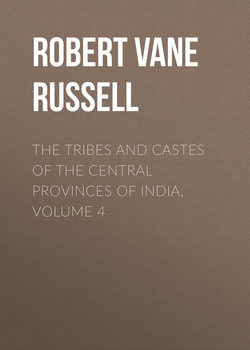Читать книгу The Tribes and Castes of the Central Provinces of India, Volume 4 - Robert Vane Russell - Страница 18
Part II
Articles on Castes and Tribes
Kumhār—Yemkala
Vol. IV
Kunbi
5. Exogamus septs
ОглавлениеEach subcaste has a number of exogamous septs or clans which serve as a table of affinities in regulating marriage. The vernacular term for these is kul. Some of the septs are named after natural objects or animals, others from titles or nicknames borne by the reputed founder of the group, or from some other caste to which he may have belonged, while others again are derived from the names of villages which maybe taken to have been the original home of the sept or clan. The following are some septs of the Tirole subcaste: Kole, jackal; Wānkhede, a village; Kadu, bitter; Jagthāp, famous; Kadam, a tree; Meghe, a cloud; Lohekari, a worker in iron; Ughde, a child who has been exposed at birth; Shinde, a palm-tree; Hagre, one who suffers from diarrhoea; Aglāwe, an incendiary; Kalamkār, a writer; Wāni (Bania), a caste; Sutār, a carpenter, and so on, A few of the groups of the Bāone subcaste are:—Kāntode, one with a torn ear; Dokarmāre, a killer of pigs; Lūte, a plunderer; Titarmāre, a pigeon-killer; and of the Khedule: Patre, a leaf-plate; Ghoremāre, one who killed a horse; Bāgmare, a tiger-slayer; Gadhe, a donkey; Burāde, one of the Burud or Basor caste; Nāktode, one with a broken nose, and so on. Each subcaste has a number of septs, a total of 66 being recorded for the Tiroles alone. The names of the septs confirm the hypothesis arrived at from a scrutiny of the subcastes that the Kunbis are largely recruited from the pre-Aryan or aboriginal tribes. Conclusions as to the origin of the caste can better be made in its home in Bombay, but it may be noted that in Canara, according to the accomplished author of A Naturalist on the Prowl26 the Kunbi is quite a primitive forest-dweller, who only a few years back lived by scattering his seed on patches of land burnt clear of vegetation, collecting myrobalans and other fruits, and snaring and trapping animals exactly like the Gonds and Baigas of the Central Provinces. Similarly in Nāsik it is stated that a large proportion of the Kunbi caste are probably derived from the primitive tribes27. Yet in the cultivated plains which he has so largely occupied, he is reckoned the equal in rank of the Kurmi and other cultivating castes of Hindustān, who in theory at any rate are of Aryan origin and of so high a grade of social purity that Brāhmans will take water from them. The only reasonable explanation of this rise in status appears to be that the Kunbi has taken possession of the land and has obtained the rank which from time immemorial belongs to the hereditary cultivator as a member and citizen of the village community. It is interesting to note that the Wanjāri Kunbis of Berār, who, being as already seen Banjāras, are of Rājpūt descent at any rate, now strenuously disclaim all connection with the Banjāra caste and regard their reception into the Kunbi community as a gain in status. At the same time the refusal of the Marātha Brāhmans to take water to drink from Kunbis may perhaps have been due to the recognition of their non-Aryan origin. Most of the Kunbis also eat fowls, which the cultivating castes of northern India would not usually do.
26
See the article entitled ‘An Anthropoid.’
27
Bombay Gazetteer; Nāsik p. 26.
